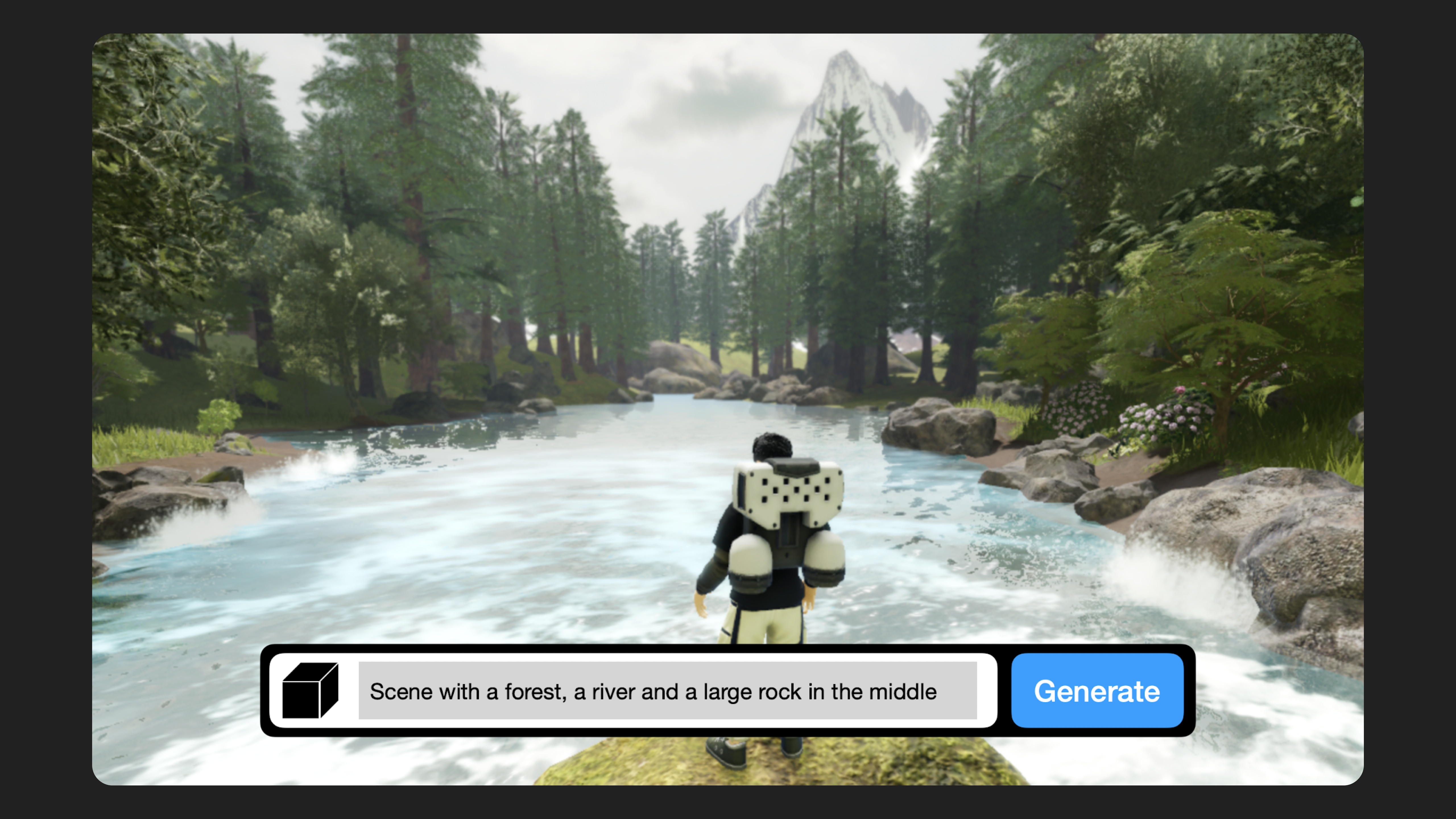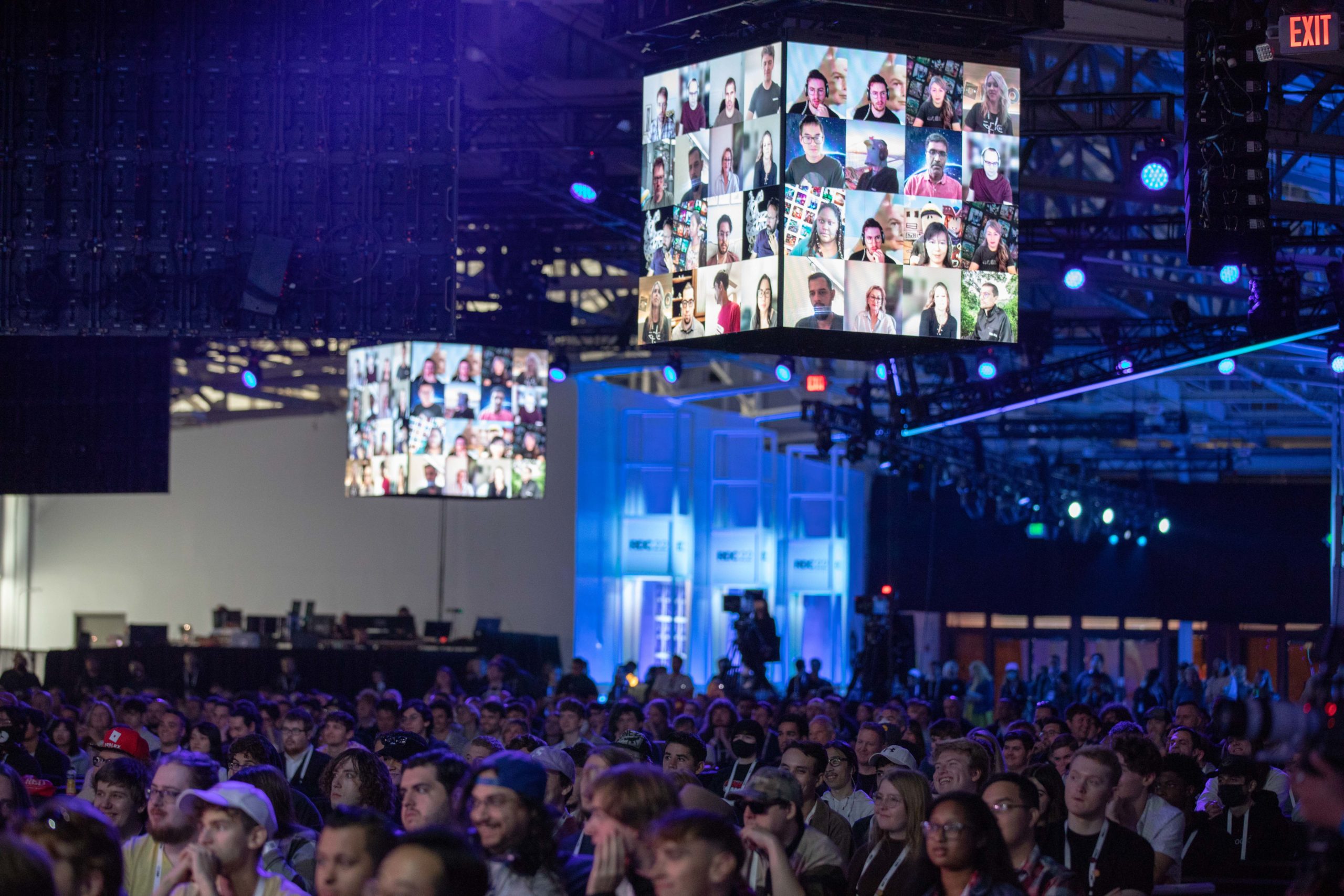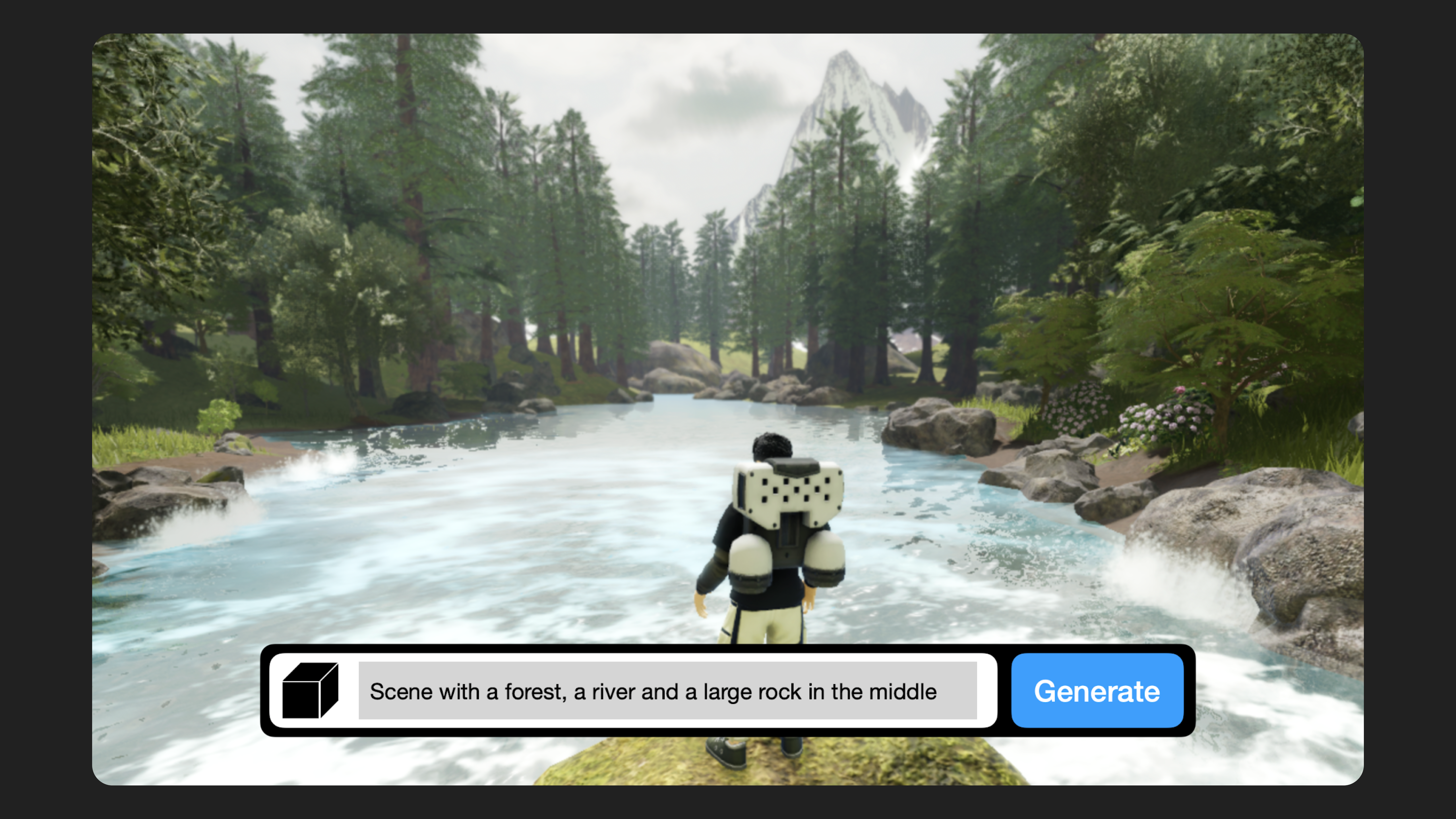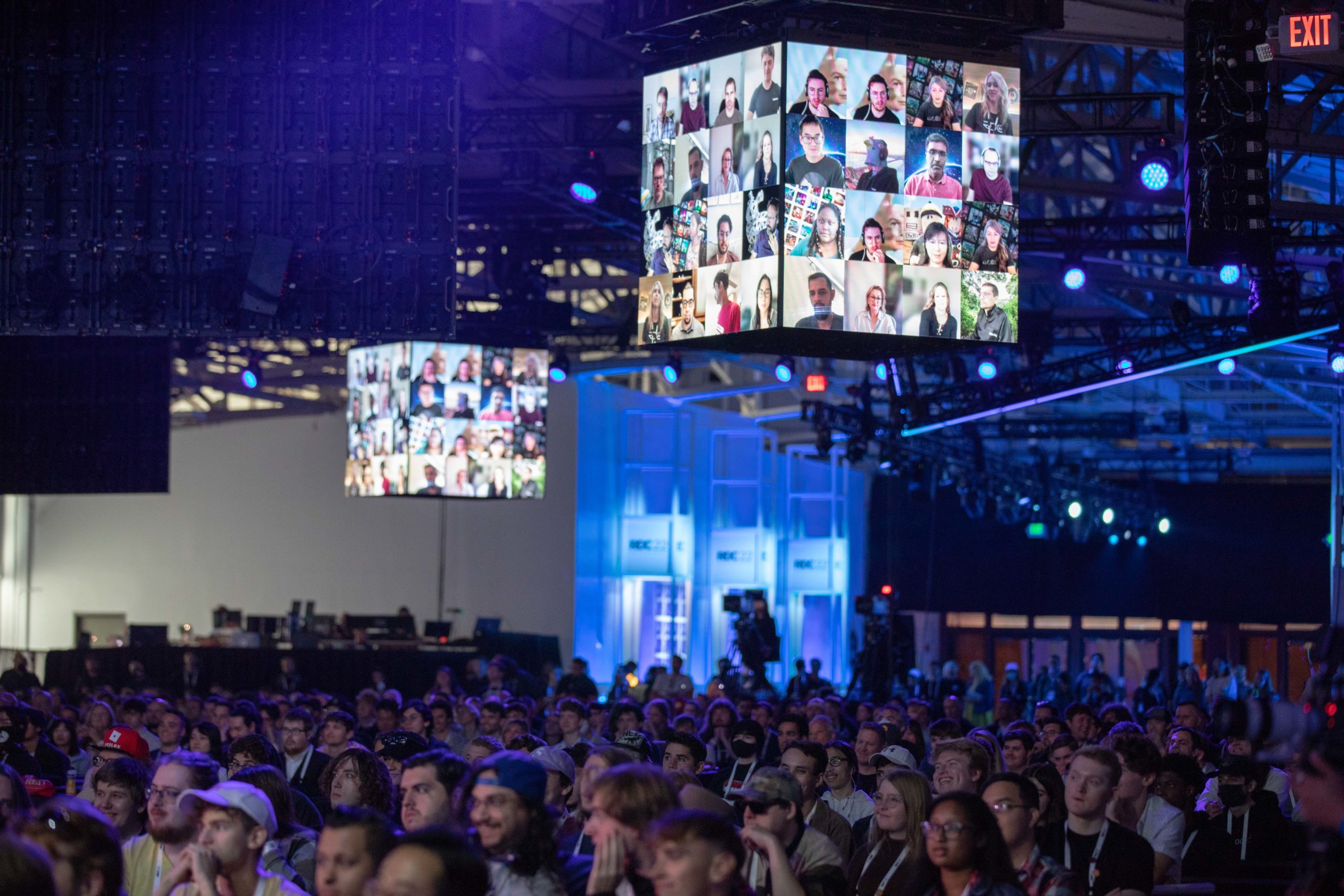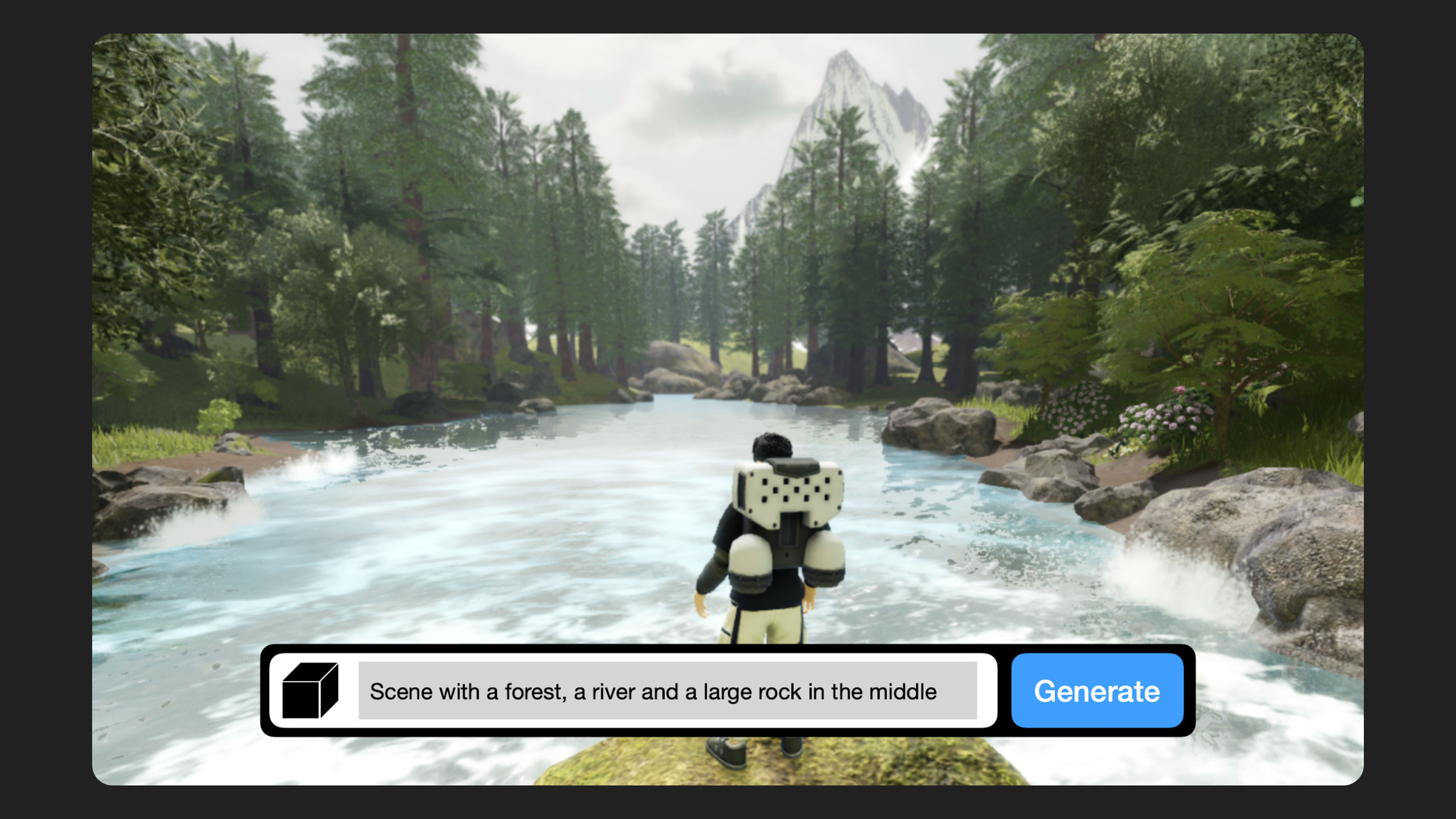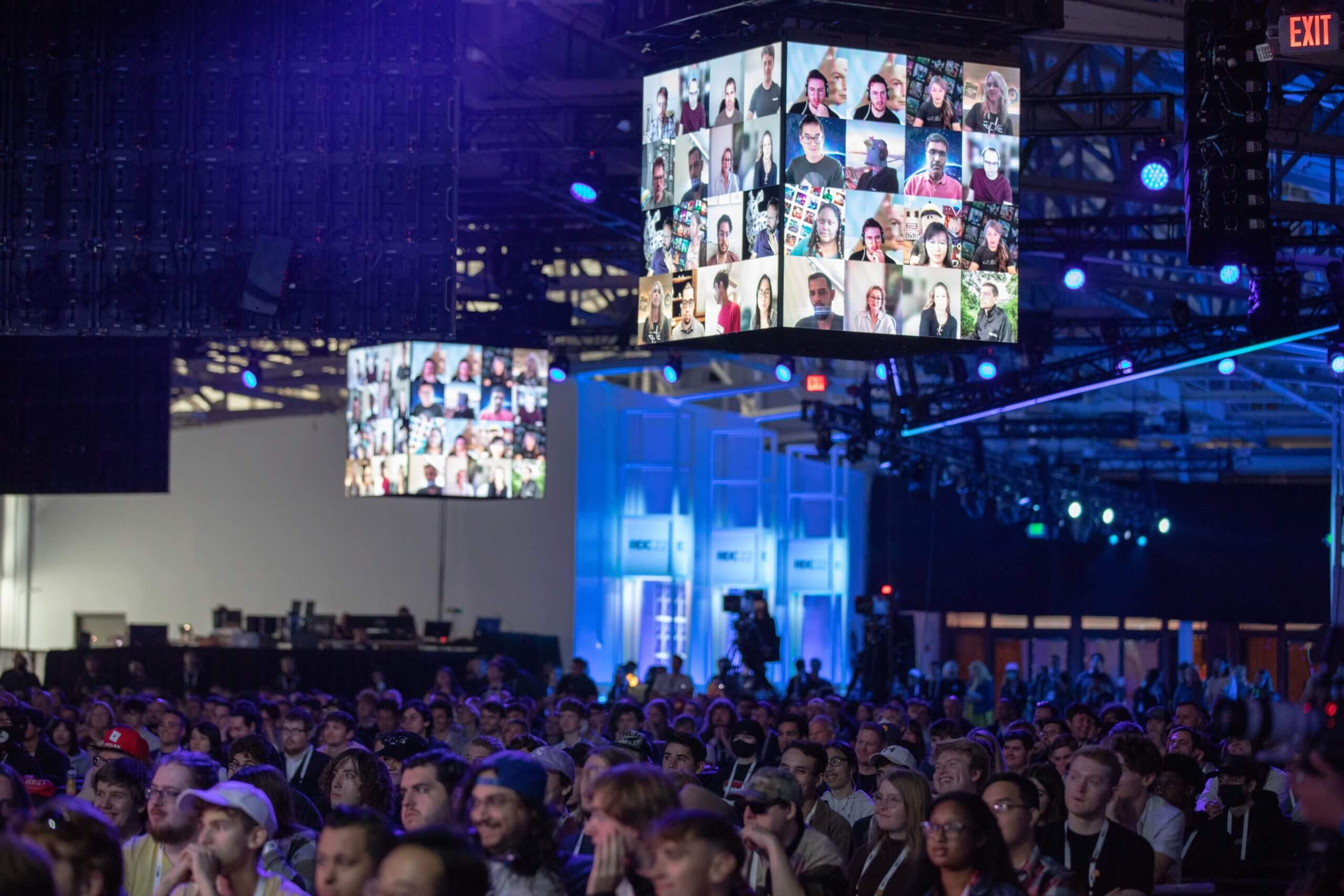Stray Gods: The Roleplaying Musical sounds fantastic. And I’m not saying that in the metaphorical sense of “Oh, this seems like it will be really cool.” No, as a musical adventure game with RPG elements, it literally sounds fantastic–the music for this game is incredible. After sitting down for two hour-long previews with narrative director David Gaider, managing director Liam Esler, and art director Benjamin Ee to discuss how this Greek mythology-inspired adventure game came to be, I’m blown away at what the team has already achieved and what they envision for the final product.
During our conversation, I took the chance to ask Gaider about the world-building that went into Stray Gods’ incredibly diverse modern-day Greek pantheon, and the team also walked me through Stray Gods’ opening 30 minutes, showed off behind-the-scenes visuals of concept art, and revealed several never-before-discussed songs from throughout the game, including a touching soliloquy from Asterius to Hecate.
Stray Gods is the debut title of developer Summerfall Studios. It sees you play as Grace (voiced by Laura Bailey), a college-dropout-turned-singer who finds herself becoming the latest and last Muse following the murder of Calliope. The surviving governing body of the Greek pantheon–known as the Chorus–condemns Grace for the crime, forcing her into a search to discover the identity of the true killer within a week’s time or face punishment in their place.
Choice is at the heart of Stray Gods’ gameplay, and the game kicks off with a big one: What type of person is Grace? You can choose for Grace to be more kickass, charming, or clever, and this decision informs what options you’ll have in certain conversations. “Kickass is aggressive and punk rock and powerful and in your face,” Esler told me. “Clever is thoughtful and strategic and knowledgeable. Charming is empathic and caring and trying to do the right thing.”
In the demo I saw, creating a kickass Grace provides you with plenty of opportunities to be confrontational and more direct during conversations; opportunities you wouldn’t have with a clever or charming Grace. For example, when Grace’s best friend, Freddie, expresses concern for how distant and depressed Grace has seemed since dropping out of college, Grace can just play things off or even be a little flirtatious in response. But a kickass Grace can also be direct in that situation and just tell Freddie how it is: Freddie is always supporting Grace, and Grace feels inadequate in how too one-sided their dynamic is.
Your choices in conversations can have small impacts, such as the direction of a conversation, or huge consequences, like which Greek gods become your allies. And as is the case in my favorite kinds of games, they can also influence who Grace ultimately gets to end up smooching by the game’s end, as Stray Gods hosts four romance options: Freddie, Pan (god of fertility), Persephone (queen of the underworld), and Apollo (god of prophecy).
And speaking of characters, Stray Gods builds on a concept most recently popularized by Hades, a game that reimagined the Greek pantheon as a collection of individuals who surprisingly aren’t actually all Greek and reinforced the notion that divine beauty could exist even in those who don’t fit the conventional idea of what’s attractive. Stray Gods goes a bit further than Hades does, however, portraying characters who are fat or have physical disabilities as attractive and desirable as well. It’s a very diverse pantheon of sexy gods.
This celebration of diversity feels most evident when Grace first meets the Chorus. She’s brought to them by Hermes, an androgynous teenage-looking Asian kid dressed to the nines in Hypebeast-inspired clothing. The Chorus themselves are composed of Athena, Apollo, Aphrodite, and Persephone (as well as Calliope, prior to her death), and while Athena and Apollo more closely resemble the traditional idea of Greek gods, Aphrodite and Persephone are noticeably darker-skinned. And aside from all of them being hot, none of them look even remotely biologically related.
This is because, within the world of Stray Gods, the Greek gods can be reborn over and over again. If a god dies near a living person, the essence of who they are, their eidolon, is passed into that person. That’s how Grace becomes the new Muse–Calliope’s eidolon enters her as Grace is holding her when she dies.
“When I came up with [the lore] originally, having the eidolon be passed on to anyone, that created an opportunity to write that, over time, after many, many times that [the eidolons] have been passed on over many deaths, and now we have perhaps a little bit more diversity than there was originally,” Gaider said.
In creating the cast, Summerfall Studios also opted to move away from most of the more popular names in Greek mythology. In the world of Stray Gods, many of the more well-known gods–like Zeus, as well as his brothers Poseidon and Hades–have completely perished or removed themselves from the pantheon entirely. This creates more room to focus on building stories around the other gods and creatures of myth. Beings like Athena, Persephone, Apollo, and Aphrodite have larger importance as the only remaining rulers of this pantheon, and those lesser than them have similarly been promoted to more important roles to fill any empty slots. This is a pantheon that has been around for many millennia, and the old guard is long gone.
Of the new interpretations, Persephone (voiced by Mary Elizabeth McGlynn) has one of the more intriguing storylines. “This is a version of Persephone who gets mad a lot because people think that her story ended when Hades took her to the underworld to be his wife,” Esler said. “But the reality is for her, that’s where her story began. She killed Hades and she took his throne and then the rest of the gods punished her for doing so and exiled her from her realm, so she’s a queen in exile. And she’s never quite forgiven them for that, even after many years, and carries around a hardness and a bitterness.”
I do think Summerfall Studios is a tad behind on the general strokes of this variation of Persephone, as thanks to games like Hades and webcomics like Lore Olympus, I don’t know of any Greek mythology fans who think Persephone’s story ends with her becoming Hades’ wife. Recent tales have already done a great job of breaking the mold of her myth and rewriting her lore so that her story does not end within the underworld, but rather truly begins there. However, Stray Gods’ Persephone is definitely one of the more corporate-like interpretations I’ve seen. She’s demanding and results-oriented, dressing like a businesswoman and treating those she deems beneath her (which, honestly, seems like almost everyone) more like employees who can be easily discarded.
As Ee explains it, when it came to creating this interpretation of Persophone, the team wanted someone who leans into both feminine and masculine vibes in terms of her design and personality. “She has extremely big girl boss energy,” Ee said. “And so a lot of the vibes that result from that is just someone who holds herself up to high esteem, someone who feels very classy. And so she’s wearing this gorgeous silk kimono-esque robe gown. Everything that she has looks expensive because she’s a queen and she’s like, ‘I demand respect.'”
Persephone moves through her scenes with a rigid authority and divine grace, the still images of her character model interspersed in a manner that juxtaposes the more fluid movements of Athena or Aphrodite or the slow meandering of Apollo. Long before she opens her mouth to sternly tell Athena to get on with sentencing Grace to death, you can visually see that she’s powerful but definitely distinct and different from her fellow gods. This visual style of storytelling extends to all the characters, with Summerfall Studios using an animatic style of movement to complement its comic book-looking visuals–in motion, the game looks more like a stylish storyboard than a stop-motion comic, with the 2D character models moving within 3D spaces.
“We pivoted to being as similar to comics as we could, like a cell-shaded look, no rendering involved,” Ee told me when explaining how the team arrived at this style. “It was clear that the identity of Stray Gods was brightening up to be that way, like a lantern in the darkness. We were starting to head towards that direction. [Summerfall Studios character artist] Jessica Lee is an insanely good artist and her dynamic posing is just out of this world. So these expressive characters were brought to life by her hand and it’s so amazing to watch what she does.”
He continued: “So we were going with this very beautiful comic book style. The idea was motion graphics, but as we were implementing our scenes and testing them out, we were realizing that our shots were very static because we were leaning so hard into being comics that we were just having a shot, like a comic panel shot, and we were finding that it just feels immediately dead, that nothing was moving in them. And so we’re like, ‘We need to come up with some sort of way so that we have some motion happening in every scene.'”
Of course, when it comes to actual books, comics have multiple panels across a single page, allowing writers and artists to redirect a reader’s eyes across the page and consequently adding movement to otherwise still scenes. That effect is harder to achieve in a visual-novel-looking adventure game since every still panel fills up the screen and the player is clicking from one still image to the next. If there’s nothing to draw the player’s attention to different parts of the screen, then it doesn’t feel like there’s any movement to the scene, even if the image on the screen is changing.
“When [a shot] takes up a whole screen, suddenly it’s really important where characters are and stuff,” Ee said. “It’s the whole science of where your eye is going to go–leading your eye is what a storyboard artist does. And so I tried my best for a bit but it was very clear that I was just a little fish in the huge ocean, and so we hired our amazing Sasha Mutch, who is a storyboard artist, to help us out with that and it’s been insane. Let me tell you, the level-up has been crazy. And so, again, the project sort of shifted around to being this beautiful animatic-style cinematic experience. Liam calls it the language of motion–it adds this whole new dimension to everything, and it still feels very comic booky, but at the same time, it felt like these characters were almost alive. You can get immersed in their story.”
But as beautiful as Stray Gods is to look at, its musical inspirations most strongly distinguish it from other adventure games. As a Muse, Grace has the divine ability to transform any moment into a chance for folks to express themselves through song. She can’t make anyone sing; she instead transforms the space around her into a musical, providing room for her and the other characters to express themselves. As a player, you don’t choose when these moments happen–they only occur during important narrative beats, where the storyline can branch. You do get to decide how the songs themselves play out though, making choices throughout each musical number that can inform the direction of the song and the story.
During the preview, the team showed me four different songs: one in which Calliope introduces herself to Grace and the two perform a duet, one in which Grace meets and is chastised by Medusa, one in which Grace and Freddie help Asterius admit his feelings for Hecate, and finally one in which Grace confronts Apollo for his insistence in refusing to use his gift of prophecy to help her discover the identity of the killer. If the showing was any indication, Stray Gods features several genres of music–such as jazz, alternative, and rock–and many of the songs can transform and shift midway through as their tone or narrative purpose evolves. Kind of like, you know, a musical.
One of my favorite examples of witnessing how a song can change occurred during Asterius’ soliloquy for Hecate. The bumbling minotaur is not a great singer and starts bombing early into the song as he tries to express himself to the goddess of witchcraft. And as Grace, you can choose to further encourage him, turn to Freddie to lend a more supportive hand, or step in yourself for a more direct opportunity to control the song. When you choose for Freddie to step in, the song loses the stilted elementary rhyming scheme from before and becomes more melodic. It’s really cute.
During songs, you have branching options much as you would with conversations in an RPG. And much like those conversations, the effects of your choices impact not only the direction of that particular song but the songs that come after it. Additionally, each song can influence the direction of the story, and consequently, the story can affect the direction of future songs and which songs you’re even able to experience. For example, each romance option culminates in a musical number, so if Grace falls in love with someone, that can influence both the direction of the game’s story as well as its music. As such, Stray Gods will not have an official soundtrack, as every song can have dozens of permutations. “When we started, it seemed like, ‘Oh, it isn’t that bad–it’s just like dialogue choices, but music. It’s not that much more complicated, is it?'” Gaider said, laughing.
Turns out, it is. It’s way more complicated. “You’re not thinking about genres, or different tempos, or everything like that,” Gaider said. “We brought on [composer] Austin [Wintory] and then the lyrics just–there are certain rules that go into making a song, right? And not just a song, but a musical. I’m aware of how narrative changes the moment you add interactivity. That agency, that changes the rules of narrative. Similarly, the rules of how a song is made or how music works changes as soon as agency enters the picture. But no one’s really done that before, so we didn’t know exactly how the rules were going to change. So we slowly had to figure out for ourselves.”
It’s something that Gaider has wanted to do for a while. Prior to co-founding Summerfall Studios, Gaider worked as the creative director at Beamdog for two years, and before that, he wrote for 17 years at BioWare, where he created the setting for the Dragon Age series and served as lead writer for Dragon Age: Origins, Dragon Age II, and Dragon Age: Inquisition. At BioWare, Gaider pitched the idea of a DLC expansion for Inquisition that would operate as a musical that would have taken place within the metaphysical realm of The Fade. That, sadly, never happened. But it did provide the inspiration for Stray Gods.
“This is a nice check off the bucket list just to see, ‘How does this work?’ and in a way, we’re sort of proving whether there’s interest out there,” Gaider said. “No one’s done it to quite to this level before, so we’re going to see. And I mean, our gut feeling, when we did the crowdfunding, we discovered that there was an audience. There are so many people that came forward and they were like, ‘This game seems like it’s made specifically for me.’ And they’re certainly not alone, but at the same time, when we were talking to publishers and stuff, there was this feeling that there’s no straight line you can draw between this game and something that’s come before to determine, ‘Is it going to be successful?'”
With not much to look at within the gaming industry, Summerfall Studios turned to the music industry for advice. Alongside Wintory, Gaider also worked with musical comedy trio Tripod, as well as art pop musician and Twitch streamer Montaigne for the songs and lyrics. “We approached it from an RPG side, the dialogue side, first,” Gaider said. “Because that part, at least, we knew we understood. I’ve done a lot of that, but it’s like I had to write it with all the critical emotional points saved for later. So I had to write everything around that. So when it comes to the big emotional part, now, instead of writing it myself, I’ve got to sit down with Austin, our composer, I’ve got to sit down with our lyricists, and we have to write that part together, and figure it out.”
Regardless of the choice you make at the start of the game, within each song, Grace has chances to be more kickass and direct, clever and strategic, or charming and empathetic. But those are just narrative consequences of the song. Summerfall Studios wanted to go above and beyond, so these options can translate into musical consequences, too. Kickass choices seem to lean a bit more into rock, while clever is a bit more jazz-focused, and charming choices are more melodic. And all of those musical choices have to naturally flow together like they all seem to belong in the same song.
“And that was the part that tricked me,” Gaider admitted. “Because I’m like, ‘Okay, the [narrative] path, you can understand.’ And then they’re like, ‘Well, but a song has a through line.’ And then they said, ‘What if the first choice that we make determines the catchphrase of the song? What if that is the through line? And then, each time you make a choice, it makes a branch. And so let’s say you have three choices. Instead of being a branch of three, it’s now a branch of nine, because every branch needs itself to branch once for each type of through line that you have active in the song.’ And they’re telling me that this is a required thing for them to do for the song. And I’m like, ‘Shit, that’s a lot of branches.'”
All of these branches culminate in a musical finale, which is Grace making her case to the Chorus at the end of the week. This final song is constructed based on the choices you’ve made in every song and major story decision up to that point, meaning one player’s finale could sound radically different in comparison to another’s. The team could not give me a hard number on how many permutations of the final song exist, but I have to imagine it’s on the large side if it has to make callbacks to dozens of possible decisions.
“I’m glad we left [the finale] for last, because it turned into a big thing when we finally got to the finale song,” Graider said. “We sat down and we just had a series of meetings where we just built it piece by piece, because it callbacks to every other song in the game. But because the songs change when you make choices, we wanted to go back and pick from the choices you made so that the callbacks you’re hearing are specifically the ones that you heard.” It sounds like a lot, and I would have loved to have been a fly on the wall to see what it’s like to record multiple versions of different verses for the same song.
Stray Gods has a lot of strong vocal talent behind its characters. I wasn’t kidding when I started this off by saying Stray Gods literally sounds fantastic–I’ve never grooved so hard to a video game preview before. There’s a lot of good music here that’s backed up by artists who know the craft, all of whom received advice and direction from Troy Baker. Beyond Bailey and McGlynn, Summerfall Studios isn’t ready to reveal any of the names of Stray Gods’ cast and asked me not to announce any voices I recognized. I did recognize quite a few though, and can say that Summerfall Studios has nabbed some incredible talent from across the voice acting and theater industries. I especially like who they got for Medusa (who brings a hissing raspiness to the role that’s simultaneously seductive and creepy as hell), but the voices for always-in-a-rush Hermes and awkwardly bookish Asterius are also inspired choices that got a knowing chuckle from me when their characters finally spoke on screen.
Of the cast I can talk about, I didn’t get a chance to hear McGlynn drop any bars, but Bailey, naturally, popped up in a lot of the songs I got to hear. Bailey does a terrific job as Grace, which comes as no surprise given her impressive lineup of acting credits and singing roles (most evident in her work for Critical Role, where she voices Campaign 1’s Vex’ahlia, Campaign 2’s Jester Lavorre, and Campaign 3’s Imogen Temult, and is a vocalist in “Your Turn to Roll” and “It’s Thursday Night”). Bailey’s musical performances for Critical Role lean a bit closer to rock but as I was watching her performances in Stray Gods, I couldn’t help but recall her saying during The Making of “Your Turn to Roll” video that she’s more used to singing sweeter and nicer-sounding songs. And that’s immediately evident in Stray Gods where most of Grace’s performances seem to be generally more melodic in nature, and all of them are fantastic. Bailey is in her element and it shows.
Summerfall Studios wants players to remain in the element, too, so beyond the choices you make, there’s no interactive aspect to any of the songs. You’re allowed to just enjoy the music. “There is not a mechanic to the songs, you’re just making choices based on how you feel,” Gaider said. “And that was another thing we had to discover because initially, we had more of a mechanic in the songs where you had points you built up. The thing we found out is that any mechanic we put in the song, suddenly players were focused on, ‘How do I build up those points?'” and not listening, really, as much to the song itself. But in [Stray Gods], we’re not just listening to a beat like, ‘This is cool. I want to dance.’ It’s like a Broadway song in that the lyrics you’re listening to are important because they are the story. All the songs happen at all the big, critical, emotional moments.”
Music is transformative, a notion that, within the world of Stray Gods, Grace can make literal. Her power as a Muse can create the space for music, but it can also create a space defined by music. Summerfall Studios calls these spaces Song Worlds, and they transform the scenery in response to music, much like the evolving sets of a Broadway performance.
“Song Worlds were our way of breaking reality in a very beautiful way,” Ee said. “So doing our research into how we could show off the musical aspect of our game, we kept coming back to Broadway stages and stuff like that, as well as checking out music videos, and one of the things that kept showing up was just these weird, sometimes props we would use. K-pop music videos were extremely helpful.”
He continued: “The production [in Broadway] happens so fast that they need to have these very striking environments that don’t need a lot of work to put into them. [The Song Worlds] are more complex, abstract in an abstract way, and the set design is based off the song vibe and what they’re saying at the moment.”
During the preview, I got to see how the team constructed one such Song World for when Grace is confronting Apollo–a fractured, shifting scene that reflects the emotional and mental state of a god who has been repeatedly cursed with the knowledge of future calamities and lacking the means to change them. Over the course of the song, we chose for Grace to be supportive of Apollo while remaining insistent that he use his gift in aid of Grace. These choices manifested in a tonal shift to the initially mournful song, which ultimately ended on a more hopeful note. In the world around Grace and Apollo, the dark space of Apollo’s mind became illuminated by the beams of a lighthouse and saw Grace and Apollo move together in harmony, with Grace’s powerful voice lending strength to Apollo’s softer vocals. It was a surprisingly beautiful end to a haunting song.
“And depending on your choices, the refrain of the song would be totally different and each of the individual verses would be totally different as well,” Esler teased. “That song is about, four to five minutes long and there are over 22 minutes of music for that song. So in a given playthrough, you’d see just a bit less than a quarter of the possible things you could see in that song.”
“Each Song World is an opportunity for us to show off and push harder on the feelings of a song, the emotions and the metaphors specifically when they’re going through lyrics and stuff and talking about depression or something like that,” Ee said. “It would be a lighthouse in the darkness kind of thing, you know what I mean? The feeling of trying to hold on in crashing waves and then dimly lit spaces that feel cramped, stuff like that where in reality these people are just singing in person in a room somewhere.”
“Generally we put songs where there are really big key decisions to be made, and a lot of those have unique Song Worlds,” Esler added. “The thing with Stray Gods that’s important to note is the songs are biogenic–they occur in the world, the characters are aware of them. This is a thing that is actually occurring and part of [Grace’s] power is we wanted to be able to create a reality around what is going on and have the song influence that reality in different ways, and that was the genesis of the idea of Song Worlds.”
I, for one, am sold on the idea of this game. Stray Gods sounds like an incredible experience–it’s definitely not one that I’ve seen before. The notion of a musical where every song evolves and changes based on choices the player makes seems like a staggering ordeal, but if Summerfall Studios pulls it off, I think there’s something special here to be excited about. For now, however, we just have to wait and see. Stray Gods: The Roleplaying Musical does not yet have a release date, though it’s scheduled to launch for PC via Steam.
GameSpot – Game News


